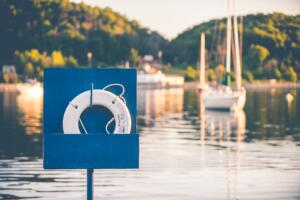 There are many ways that you can ensure safety as well as enjoyment as a boat operator. It is a good idea to familiarize yourself with safety equipment and consider items that will provide comfort while using your vessel.
There are many ways that you can ensure safety as well as enjoyment as a boat operator. It is a good idea to familiarize yourself with safety equipment and consider items that will provide comfort while using your vessel.
Always ensure that you have the valid Certificate of Number while the boat is in use. This will allow you to prove registration and ownership should you be approached by law enforcement.
You should also keep on your boat at least one wearable life jacket for each person on board.
The life jackets must be U.S. Coast Guard-approved, which would be indicated on the label. They also must be the appropriate size and type for each person, and in good condition.
A throwable, such as a life ring or flotation cushion, must be kept on board for vessels 16 feet or longer.
In the case of an emergency, a whistle and an emergency light would be necessary. Emergency lights come in many varieties such as strobe lights that can be attached to the boat, lantern-styles, and utility style for bright, adequate illumination. Distress signals are required for boat use as well. Signals such as an orange distress flag (used by day only), or signal flares.
Another item required to keep on board for safe boating is a fire extinguisher. Although you are surrounded by water, it is still necessary to keep a fire extinguisher handy in case of a fire. Be sure that you have the correct type for your boat, meeting the minimum requirements for the size and type of your vessel.
There are some situations in which you may need to make lots of noise, besides the laughter and fun from passengers on board. In meeting, crossing, or overtaking situations, sound signals are required. This is particularly during times of reduced visibility or while at anchor. You will need to keep at least one sound producing device available, such as a bell, a whistle, air horn, or gong.
To aide in navigation, it is helpful to keep a lake map available for reference. Many boats come equipped with GPS, which is the most convenient way to navigate waters.
But in the absence of GPS, or if it fails for whatever reason, keeping a lake map would ensure efficient navigation. Lake maps also inform of any lake hazards, general configuration, and character of the bottom and will include prominent landmarks and facilities.
Besides safety equipment, there are many things that you can keep on your boat that will ensure comfort and convenience. A VHF Radio would be used for communication and emergency traffic, and an AM-FM radio would be great for your favorite tunes or to catch up on local news.
A compass is a great idea to keep on board, as well. You can purchase a magnetic compass to ensure that your boat is pointed in the right direction at all times.
Be sure to always keep a tow line on board, and that it is an efficient length. 75′ is recommended, by at least 1/2″ thick. A small tool kit and spare parts would come in handy should you ever find yourself in a situation that requires repair.
Waterproof flashlights in various sizes and styles can be purchased as well and would be easy to tuck into a small space out of the way. And don’t forget extra batteries!

